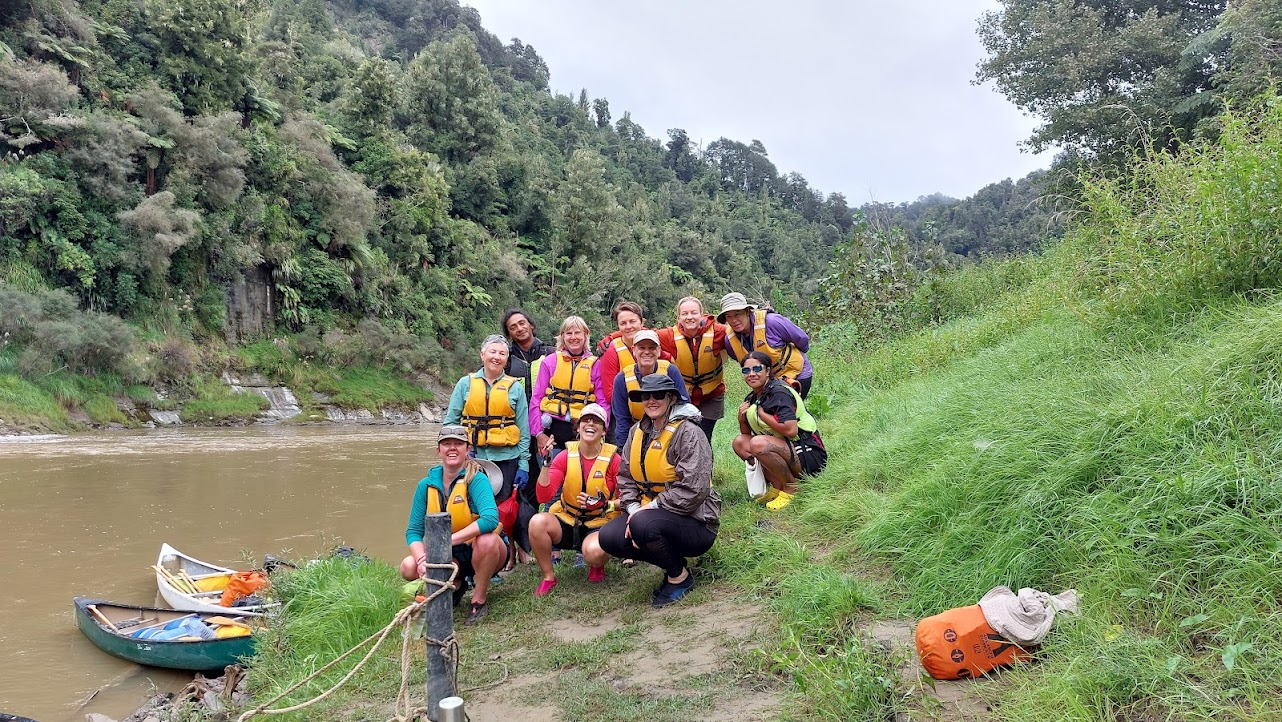Friday 17 March
We left Wellington at 3.45pm in the club van and arrived at Ōhākune Top 10 Holiday Park at around 9pm.
Day 1 (Ōhākune and Raetihi)
Our plan was to enter the river at Ōhinepane, but Unique Whanganui (UW) said the river was too high and swift for us to start that day. Instead, we had a café breakfast at Ōhākune and did a short local walk (Mangateitei River walkway), then drove to Raetihi Holiday Park to meet the UW team (who provided us with lunch). We were introduced to our Awa navigators, Hone and Maka. After lunch we walked part of the Old Coach Road route from Ōhākune railway station to the old Hapuawhenua Viaduct and back. Then we returned to Raetihi, where dinner was ready for us. The UW team explained how to pack our gear in 50L dry bags and 30L barrels, and we had an early night to be ready for our early start on Sunday.
Day 2 (Whakahoro to John Coull campsite, 37.5km, 6hrs)
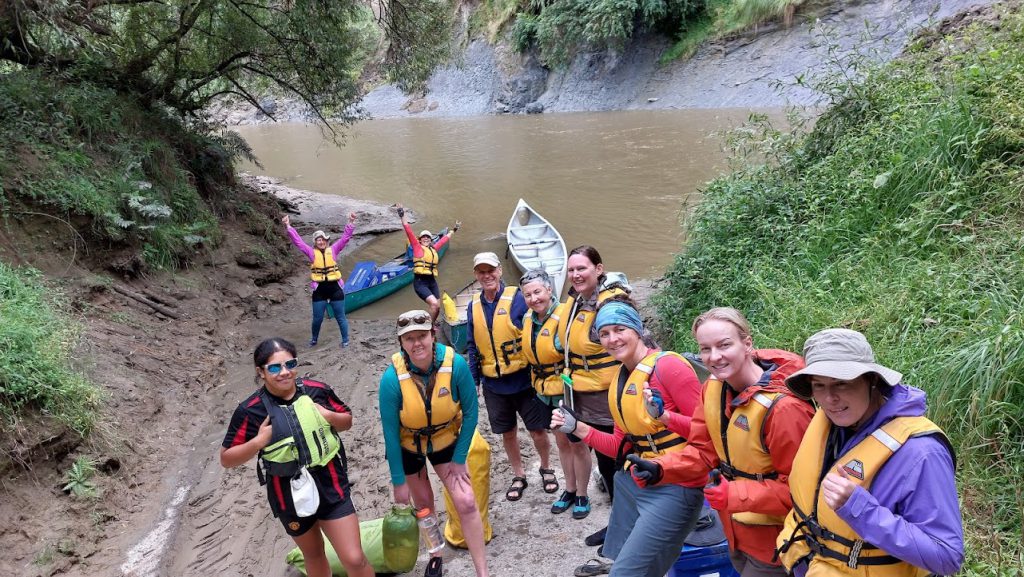
Alarms were set for 5.30am, with breakfast at 6am. We were driven to Whakahoro (arriving around 9.30am) to enter the water of the Retāruke River (just after 10am), 400m upstream from its confluence with the Whanganui River. Our group was in 2 two-person canoes and 1 six-person canoe (with Maka steering). Hone had another two-person canoe to himself, loaded up with food and cooking equipment. People in the two-person canoes had some steering practice before paddling down to the Whanganui River, straight into somewhat “bouncier” water. The river level was still fairly high so our journey was faster than usual.
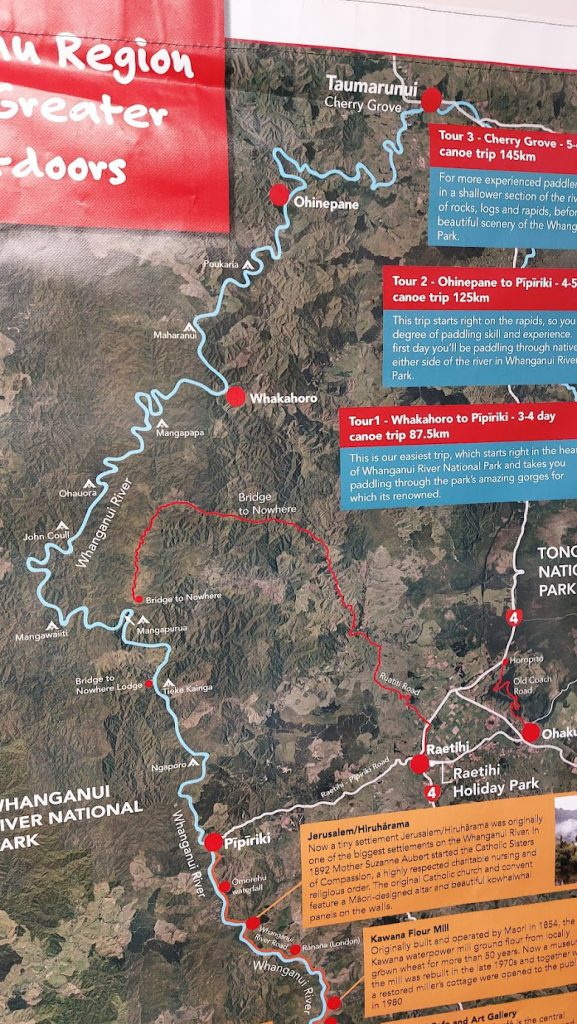
The day was fine with little wind. Swapping around of paddlers between and within canoes gave us different experiences. We had brought our own smaller dry bags, in which we kept the things we wanted access to while paddling, such as snacks, water, sunblock, a rain jacket etc. We ate lunch at the Mangapapa campsite, and arrived at John Coull Hut and campsite at around 3.45pm. The river was so high there was no gravel beach to land on, so we paddled up to the grassy bank, and Hone tied the canoes to posts. Then we carried all our dry bags, barrels, and other equipment up to the campsite and set up tents while Hone and Maka prepared dinner. During the evening we watched for bats, and saw several. Around 9pm we heard a kiwi call. There may have been more calls but I was soon asleep.

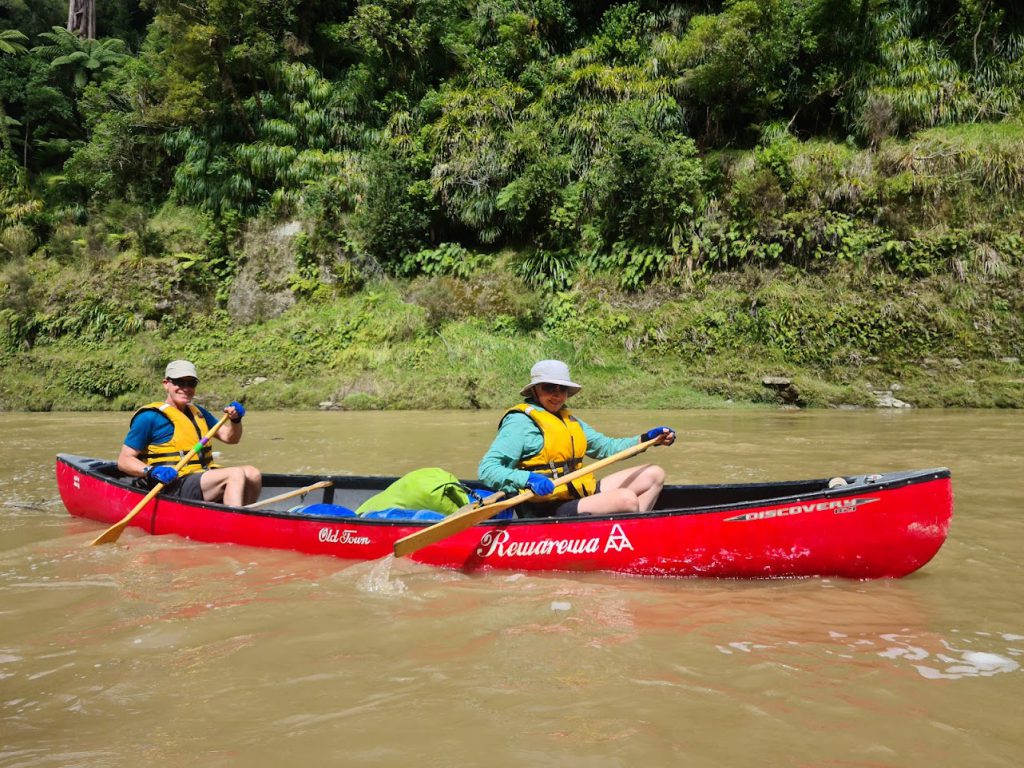
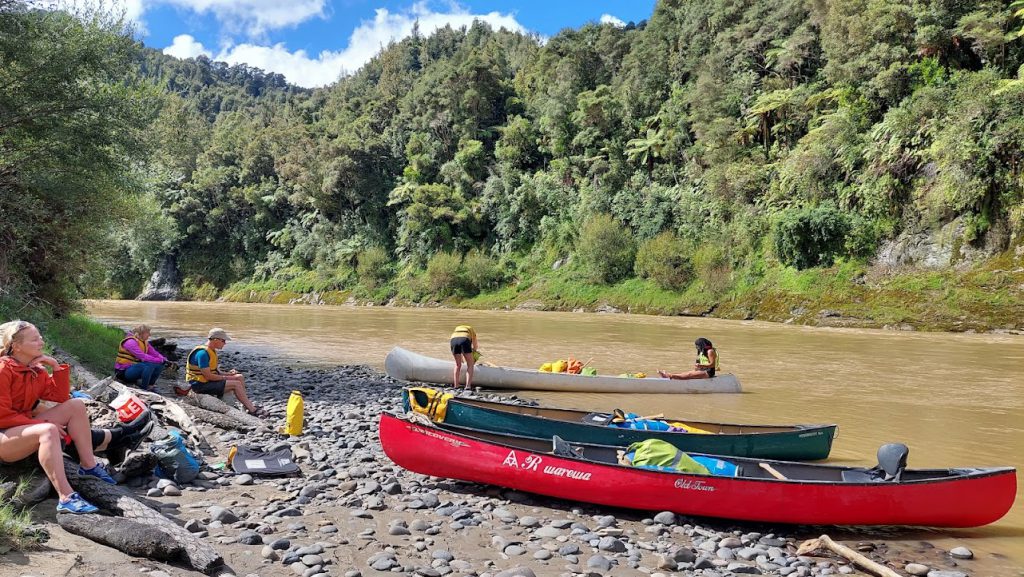
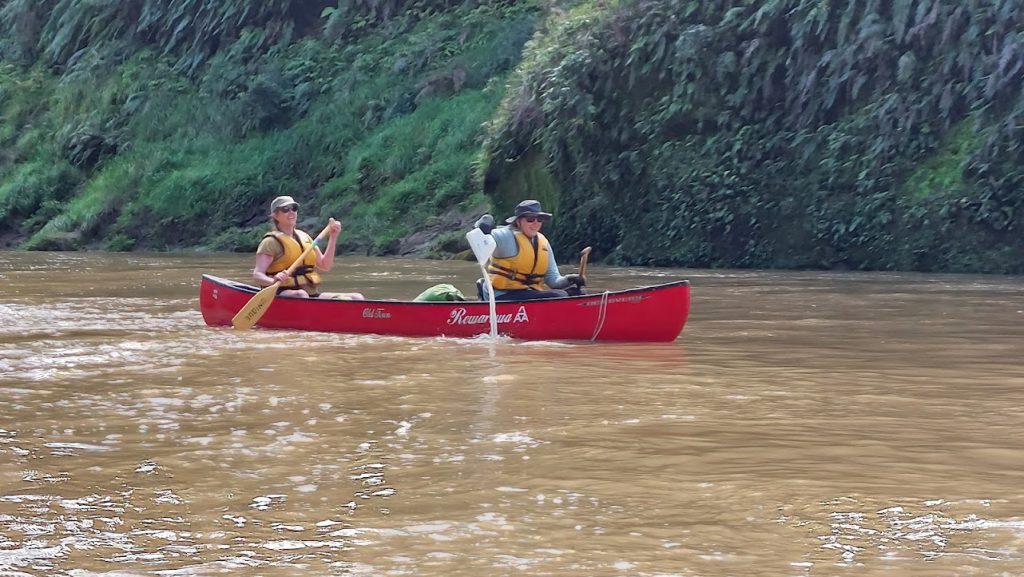
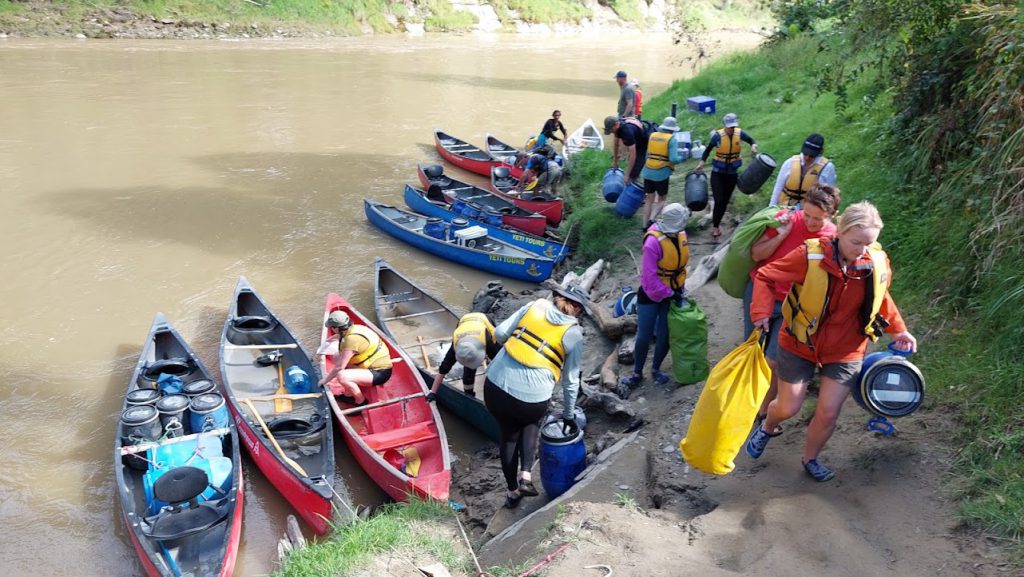
Day 3 (John Coull campsite to Tieke Kāinga, 29km, 5hrs)
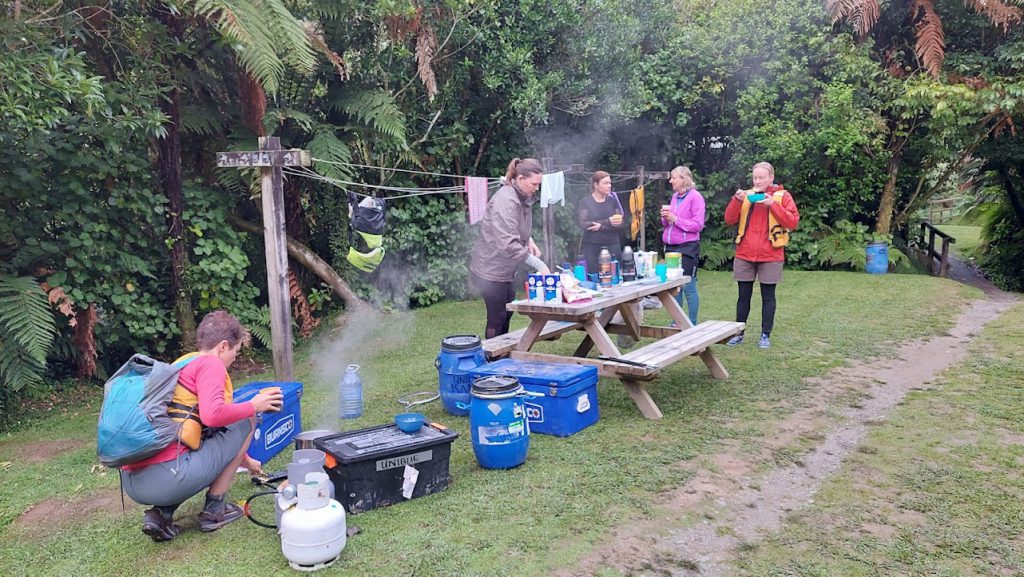
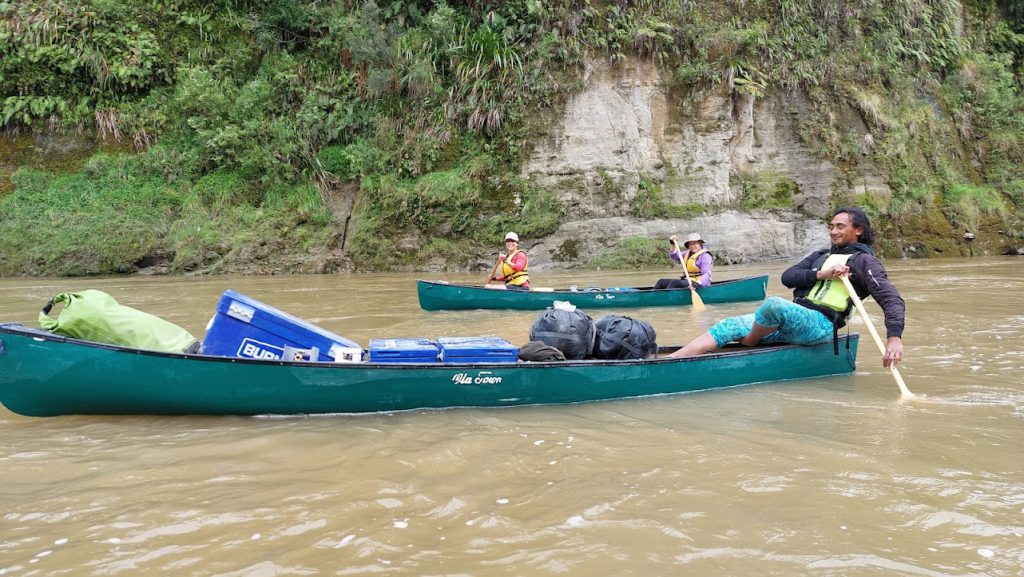
With breakfast at a more leisurely 8am, we were back on the river around 9.15am. The day was cloudy but calm.
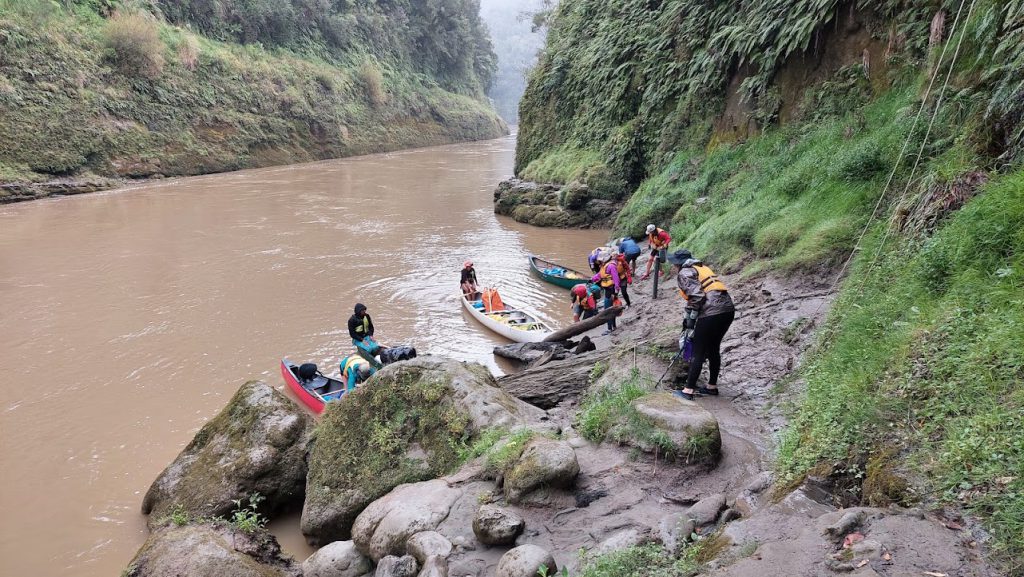
Downstream from the Mangawaiiti campsite (at 11.20am) we had a capsize. Laura and Kate’s canoe overturned while they were passing through some choppy water bordered by a large eddy; the eddy’s flow was stronger than anticipated.

Kate and Laura surfaced holding their oars and reaching for the canoe. Maka whistled ahead to Hone, who’d led the way, while those in the six-person canoe paddled strongly to avoid getting turned by the eddy. In the space of five minutes, Hone had the overturned canoe’s prow up on the side of his canoe, water tipped out and the canoe right way up, and helped Laura and Kate get back onboard.

When we reached Mangapurua Landing, we moored up so we could go on the popular Bridge to Nowhere walk. The landing area was congested with many canoes, and the current pushed Natasha and Noel downstream to the opposite bank. Hone helped them cross against the current by paddling side by side with them, slightly upstream. The easy walk to the bridge takes around 30-40 minutes. It looked a little incongruous coming upon the well constructed concrete bridge (completed in 1936) spanning a deep drop over a river and surrounded by steep, tree fern-covered hillsides.
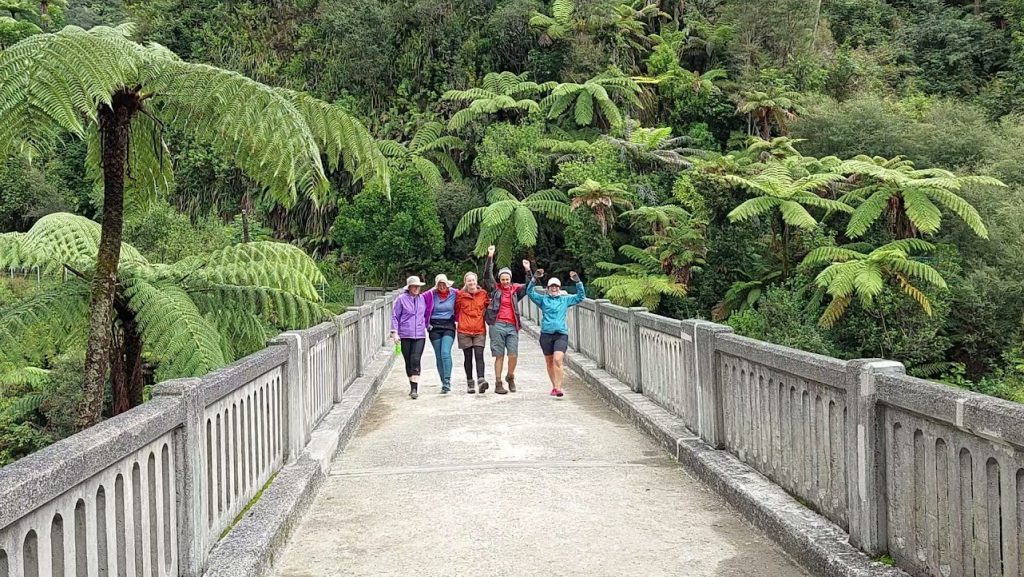
We’d left our life jackets in the shelter just up from the Landing, but on return Natasha discovered hers wasn’t there any more. The few jackets still there were from another company. Around this time a jet boat driver arrived to pick up two cyclists (who were doing a section of the Te Araroa Trail) and the driver gave Natasha a spare jacket.
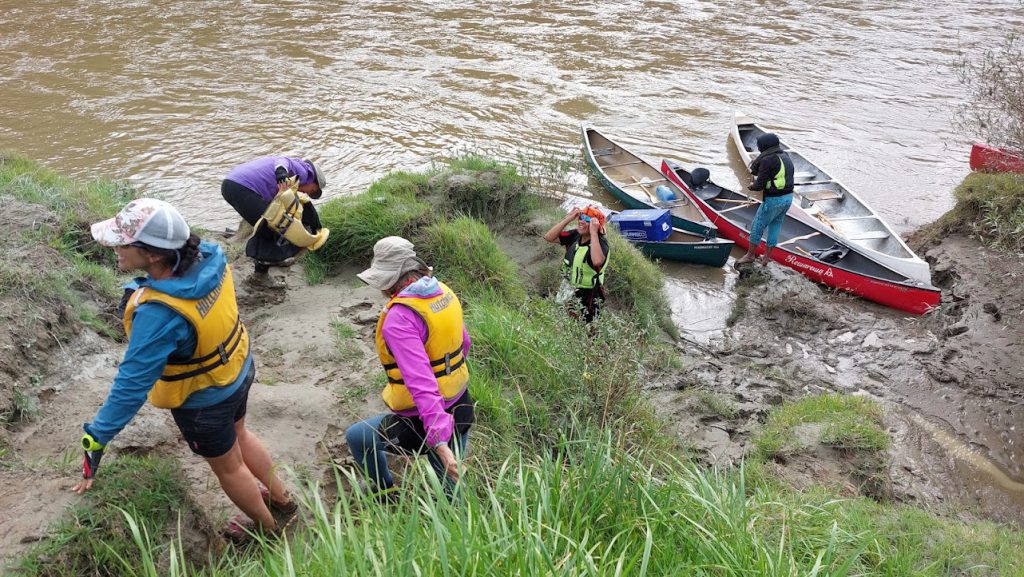
At 3pm we had a rather late lunch on the gravel beach at the Mangapurua campsite, just downstream from the Landing. Light rain fell while we ate. We reached Tieke at 4.40pm and hauled up our gear to the camping area. We were welcomed on to the marae with a pōwhiri; Rory spoke on behalf of our group and we all sang a waiata. During the remainder of the day we relaxed and wandered about, had dinner and helped clean up, and relaxed some more. Our group slept in the whare “Te Puawaitanga o Hinekura” (“the flowering of Hinekura”, I think), and other groups of “freedom” paddlers stayed in the DOC hut bunkrooms.
Day 4 (Tieke Kāinga)
Rain started around 7am and continued for several hours before clearing up mid-afternoon. Hone checked the river level at 1am and 4am, shifting all canoes to higher locations. We gathered for breakfast at 9am.

Afterwards we cleaned the DOC bunkrooms to make them ready for the next arrivals. Another Unique Whanganui group was expected to arrive after lunch and we were invited to participate in the pōwhiri to welcome them, so we spent the morning practising a waiata, and Maj-Britt prepared for the kaikaranga (caller) role.
A group of about 20 high school pupils and their guides arrived at the marae mid-morning, wet and cold, some shivering. After biscuits and hot drinks and some jumping and stomping, they looked much livelier and ready to continue their journey. When the UW group of mostly white-haired “kaumātua” arrived, they were in much better shape than the school group, and we went down to the river (wearing life jackets) to help them carry up their gear. The pōwhiri took place during the afternoon; fortunately the rain had stopped by then. We were free to roam, but told not to go down to the river unless we wore a life jacket.

Little John, one of the haukāinga (the local people) keeping ahi kā (maintaining continuous occupation of Tieke) took me, Rory, and Noel through the bush for a special view of the river. We even had to close our eyes for the final few metres.
Every day Hone asked us for our Good, Interesting, and Awesome experiences of the preceding day. Watching the river level rise, as measured against the stone landing steps on the far side of the river, was definitely Interesting for me. The possibility that we might have to spend another day at Tieke if the Whanganui River rose too much did not concern me at all.
Day 5 (Tieke Kāinga to Pipiriki, 21.5km, 3hrs)
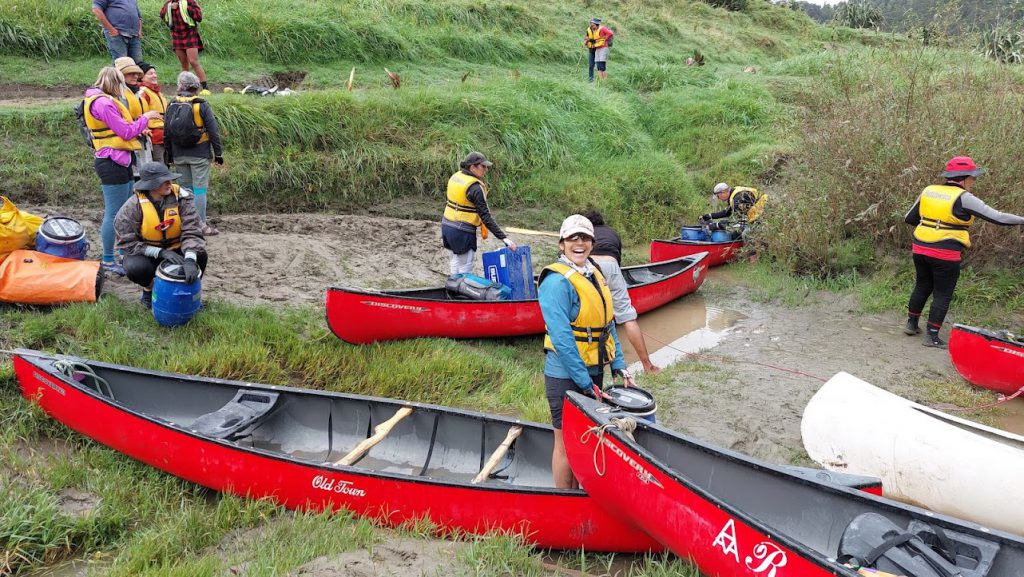
This last day of the Whanganui River canoe journey is a short one, but one that typically provides a lot of exciting rapids. However, because the river level was still very high, there wasn’t as much white water as usual; rapids and gravel banks were submerged under the volume of extra water. For security, we travelled in convoy with the three canoes of the second UW group.
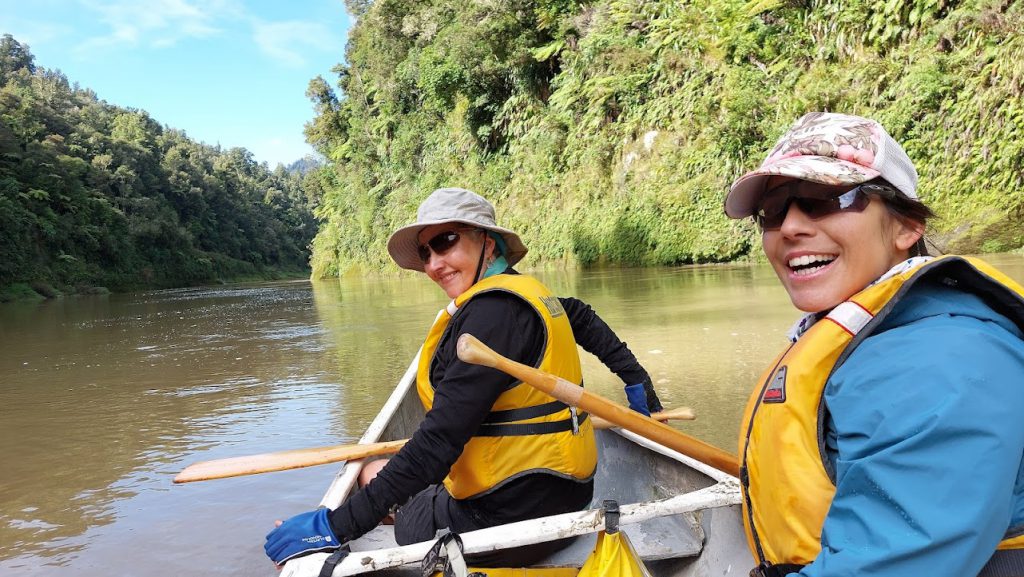
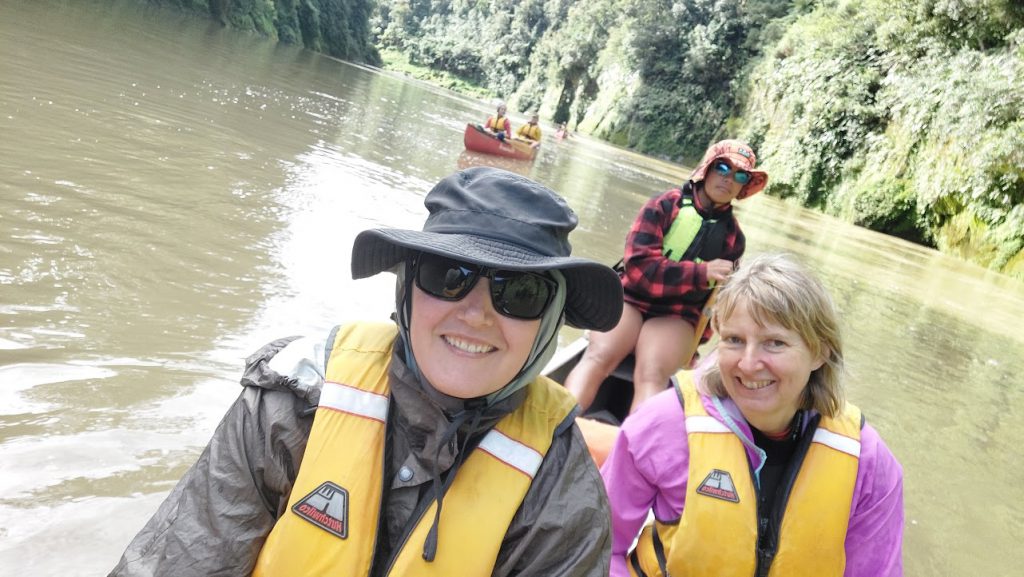
Our guide, Maka, was amazed that the often gnarly Ngaporo rapid just wasn’t visible. But where the rapid should have been still had very strong currents and was immediately followed by a large and powerful eddy. My knees gripped the sides of the canoe and I paddled like my life depended on it. I’d been tipped out at Ngaporo on a previous trip and I really did not want it to happen again. But all good this time. There were more opportunities to come out in the rapids towards Pipiriki, including the one known as “the 50-50”, but we negotiated all safely and arrived at the boat ramp before 1pm.
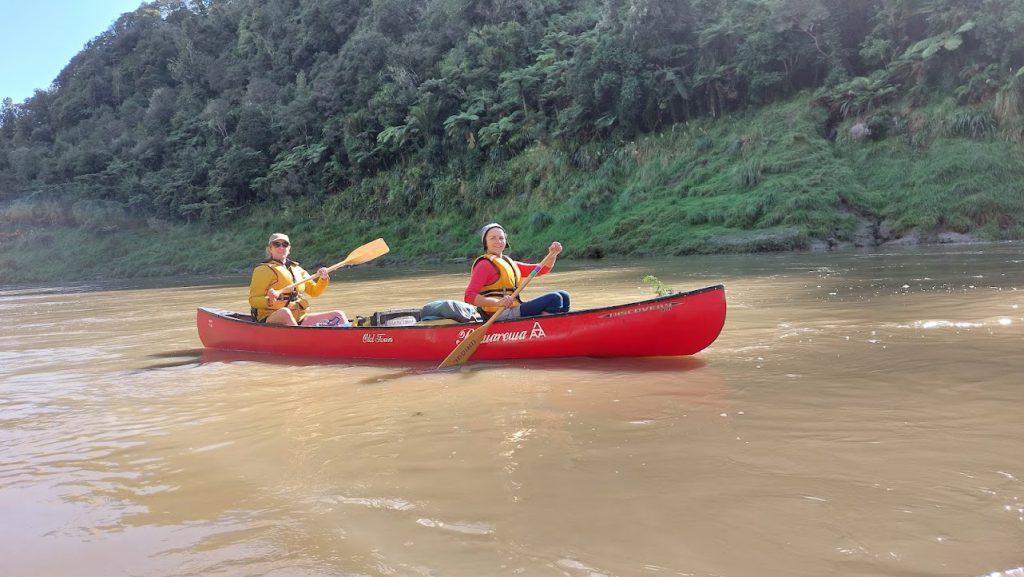
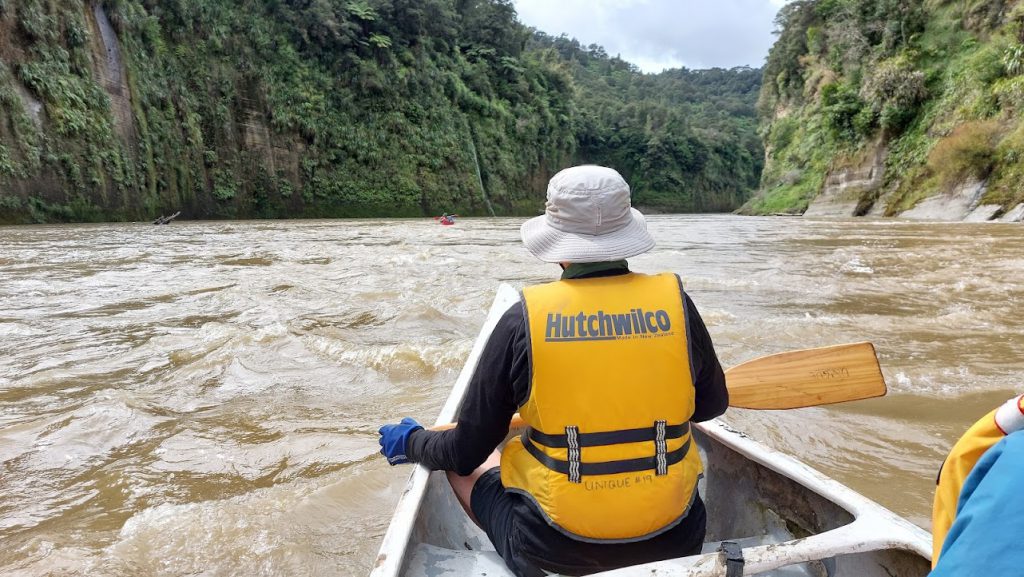
The canoes were loaded onto a trailer and we piled into two vans for our journey back to the Raetihi Holiday Park, where we used the very welcome hot showers. The club van was there, but the key had ended up in Whanganui, so we had to wait a little while to get access to some of our gear. After hot drinks and food at a Raetihi café, we headed home. A fantastic experience for all of us!
General tips
- Bring cycling gloves so you don’t get blisters from paddling.
- Footwear for the canoe: we wore boat shoes, light trainers, or sandals. On the Bridge to Nowhere walk, most kept with their canoe footwear, or brought walking shoes to change into.
- Be prepared for changeable weather; have sunblock and a sunhat with you, but also a warm layer and rain jacket.
- Keep insect repellent handy when you’re on the riverbank – the sandflies got us good while we were stuck in the mud, shifting canoes.
Comments from the team
Natasha:
Good: Unexpected but fun day in Ōhākune walking Old Coach Rd; custard for pudding!
Interesting: How quickly the river level rose, and that the river current was deceptively strong. Not having cell phone reception for 5 days. No van key at the end.
Awesome: Paddling on the river and going so quickly; all the waterfalls along the way. Sleeping in the whare on the marae was unique. A positive and helpful group.
Rory:
Really enjoyed learning how to steer a canoe; strong eddy currents and whirlpools made for some interesting moments. We were grateful for being able to swap into the 6-seater canoe to rest our arms after a few hours. Loved seeing the bats and hearing a kiwi while camping, and it was a great experience to be able to take part in the pōwhiri at the marae. We were pleased that our dry bags worked well, and everything inside was still dry at the end of each day (including our phones).
Having energy bars on hand was very helpful for a quick pick me up after each day on the river. The hardest part was trying to sleep through the snoring after another group joined us at the marae – bring earplugs.
Laura:
The food was fine, but as a vegetarian, it was not that nutritious. I recommend taking snacks and some vegetarian protein to put in lunchtime sandwiches and dinners.
If you are using their equipment, check what they give you. We were missing one mattress, and two tents had no pegs.
I feared falling in, but when it happened, it wasn’t that bad. The guides were very good at staying calm, getting our boat the right way up again, and talking us through getting back into the boat.
I did the Bridge to Nowhere walk in my reef shoes; the track is fairly flat so this was okay.
Take plunger coffee for the Marae; they have a large plunger.
Lizzie:
I felt very lucky and grateful to be part of the trip down the river. Such a unique experience on what I think must be one of the most beautiful rivers and gorges in the world.
Maj-Britt:
Definitely a unique and rewarding cultural experience. My understanding of the Awa (river), the people (mana whenua) of the area, and their relationship to each other increased significantly, and also showed me how much more there was to understand. Having the opportunity to participate in a pōwhiri from the welcoming side was a huge privilege and highlight.
Our guides’ connection to and skill on the Awa was clear through the trip, which meant we could more fully enjoy the beauty of the river. Logistics were more a mixed bag, with food-wise, going from famine to feast (at the marae).
Tip – ignore the kai (food) spiel. Bring lots of snacks and some back up food and condiments (if you can’t eat mayonnaise). Massive thanks to Laura for the relish for the many salad leaf wraps.
Meredith:
It was so precious to disconnect from technology and reconnect with nature and (in my case) my sister Lizzie.
We recommend Unique Whanganui to anyone considering a Whanganui River Journey as an individual or in a group. They are so caring and patient, and willing to share their culture and navigation skills.
Thanks to Hone and Maka, by the end of the journey we were all amaaaaaaaazing paddlers. Ngā mihi nui to the Unique Whanganui crew and to Uncle Wiri and Little John from Tieke Marae.

